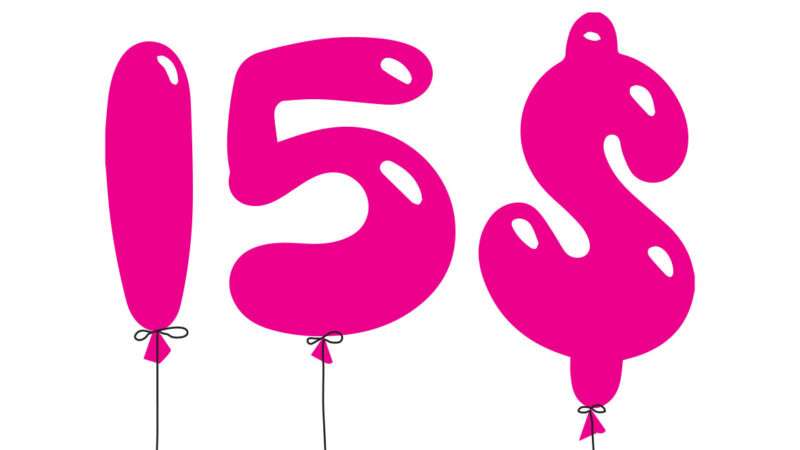
Would raising the federal minimum wage to $15 an hour cost jobs? That may seem like a strange question to ask. Forcing an economy-wide hike in the price of something typically means that people will purchase less of it. Other things being equal, forcing employers to pay more for low-wage labor is likely to mean they will employ fewer people.
In recent years, however, liberal policy wonks and Democratic Party stalwarts have begun to reject this answer, claiming, contrary to considerable evidence, that raising the minimum wage might result in no job losses at all. In 2014, President Barack Obama and Senate Democrats proposed raising the federal wage floor from $7.25 to $10.10 an hour. A Congressional Budget Office (CBO) analysis found that the proposal could reduce employment by 500,000 jobs. Yet the White House brushed off this analysis. “Zero is a perfectly reasonable estimate of the impact of minimum wage on employment,” said Obama administration economic adviser Jason Furman.
Since then, progressive lawmakers have continued to minimize or dismiss the possibility of negative employment effects from raising the minimum wage, even while backing proposals to raise it higher and higher. In 2019, Sen. Bernie Sanders (I–Vt.) cited a study from the union-backed Economic Policy Institute (EPI) that assumed no net job loss after instituting a $15 minimum wage.
This year, Democrats on the House Education and Labor Committee who favor a $15 federal minimum wage cited another EPI analysis. “High quality academic scholarship confirms that modest increases in the minimum wage have not led to detectable job losses,” it said.
What counts as modest? The EPI didn’t say. But President Joe Biden tucked a $15 minimum wage into the initial version of his $1.9 trillion COVID relief plan, which in theory was intended to boost the economy rather than harm it.
The debate goes back to a 1993 study by center-left economists Alan Krueger and David Card. In a paper published by the National Bureau of Economic Research, they examined the effect of a 1992 hike in New Jersey’s minimum wage by looking at fast-food restaurants in that state and a comparable sample across the border in Pennsylvania. They found no evidence that the New Jersey restaurants shed more jobs following the wage hike.
There were reasons to be wary of drawing larger policy lessons from that finding. For one, the study looked at less than a year’s worth of data. For another, the economies of New Jersey and Pennsylvania are not perfectly comparable, owing to various tax, regulatory, and other local factors. And the fast-food restaurants Krueger and Card studied were largely chains, which tend to be better capitalized than small, independent businesses, which are apt to be more sensitive to increases in labor costs. Finally, New Jersey’s wage increase was relatively small: a bump from $4.25 to $5.05 an hour.
Their paper nevertheless kicked off a revolution in left-of-center economic thinking. Many respected economists and policy makers on the left now believe and argue minimum wage hikes have minimal negative effects on employment.
Still, there are dissenters. They include University of California, Irvine, -economist David Neumark, who in January co-authored a survey that looked at 30 years of economic research on the minimum wage. That paper, also published by the National Bureau of Economic Research, found that a “clear preponderance”—almost 80 percent—of minimum wage studies since the beginning of the Clinton administration concluded that hikes cost jobs.
Some studies have found that fast-food restaurants cover wage hikes by passing the cost along to consumers rather than reducing employment. At best, this would mean a minimum wage hike acts as a kind of unacknowledged, poorly targeted tax increase that makes fast-food customers (not a particularly wealthy cohort) pay for higher federally mandated wages.
There is also the issue of scale. The 1992 New Jersey hike studied by Card and Krueger increased the base wage by less than 20 percent. Raising the federal minimum wage to $15 an hour would more than double it. A small hike might have a modest effect, especially in pricey urban areas where wages are already relatively high. A national doubling of the minimum wage is likely to have a bigger impact, especially in poorer and rural areas.
Krueger himself raised concerns about the push for a $15 federal minimum before his death. Such a change, he warned in a 2015 New York Times op-ed, “is beyond international experience, and could well be counterproductive. Although some high-wage cities and states could probably absorb a $15-an-hour minimum wage with little or no job loss, it is far from clear that the same could be said for every state, city and town in the United States.” Krueger wasn’t disowning his previous work; he was simply arguing that Democratic policy wisdom had taken his conclusions too far.
The Congressional Budget Office, meanwhile, continues to challenge the notion that increasing the minimum wage has a negligible impact on employment. In February, the nonpartisan budget watchdog produced an analysis of raising the minimum wage to $15.
By the time it took full effect in 2025, the CBO found, the change would result in a net loss of 1.4 million jobs. It said the effect would be concentrated among younger, less-skilled, low-wage workers, the group hit hardest by the COVID-19 recession. As it turned out, answering the original question about whether a wage hike will cost jobs is not so difficult. It takes only one word: Yes.
from Latest – Reason.com https://ift.tt/3sfXdUF
via IFTTT